Don’t dress inappropriately when visiting sacred sites
We get it — if it’s 90 degrees in Rome, you don’t want to wear a lot of clothing. But it’s important to recognize where you’ll be each day when you decide on your outfit. Many churches in Italy, especially the cathedrals, have dress codes. Your skirts or shorts must go to at least your knees. You must also have covered shoulders. Otherwise, expect to pay in cash for a poncho or be denied entry. You do get to keep the poncho, though ideally, you can pack with these site visits in mind.
When visiting sacred sites, like churches still in operation, it’s also essential to remember that people may be using it as such. Folks in the sanctuary might be praying or seeking spiritual refuge. Try to keep your voice down, obey any signs prohibiting photography, and be respectful. Americans have a reputation for speaking loudly, even when talking in what we believe to be a typical conversational volume. Just be aware of your conversations, or keep them to a minimum.
Also, silence your cell phones. Even a quiet ringtone can sound like a rock concert in a stunning Baroque cathedral with excellent acoustics. The name of the game for sacred sites and spaces is simply respect. So long as you keep that in mind, you should feel comfortable if you choose to visit these places.
Don’t touch the water at Trevi Fountain
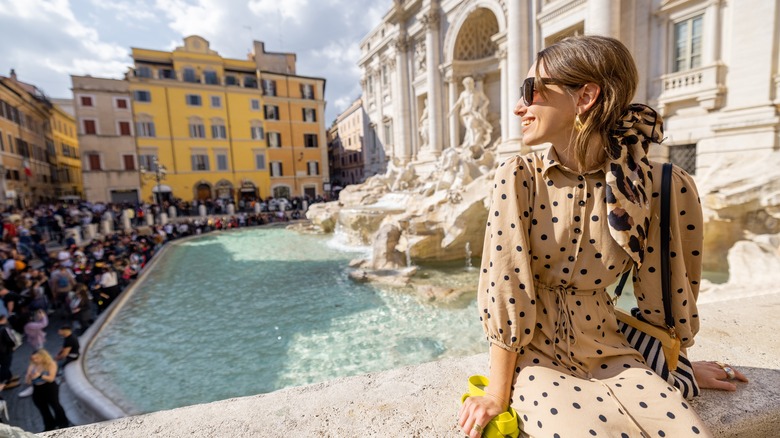
Bad behavior on social media of tourists going into the Trevi Fountain, stealing coins, or trying to take water home has caused uproar in Rome. Authorities are even considering putting up a physical barrier so that visitors can’t get too close to the fountain anymore. Messing around with or getting in the water at the fountain can get you arrested and slapped with a hefty fine. Even eating or drinking on the steps leading to the fountain can incur significant fines as well.
You can still live your “Lizzie McGuire Movie” dreams and toss a coin in the fountain; don’t worry about that. Just don’t change your mind and try fishing it back out again. Taking money out of the fountain is also illegal. Even if it wasn’t, trying to take your money back would be in poor taste, as the coins are collected and donated to different charities. The fountain’s coins are a massive revenue source for those organizations.
If you’re concerned about rules around places like the Trevi Fountain, just look around. Often, there are signs denoting prohibited activities. But sometimes, those signs just aren’t there. An excellent way to determine if an activity is allowed is to see what others are doing. If a few tourists are doing something, but folks speaking Italian aren’t doing those things, it’s better not to do it. Observing locals isn’t just a good way to find quality food in restaurants — it’s also a way to determine if a behavior is atypical.
Don’t forget to validate a train ticket

Leopatrizi/Getty Images
Riding public transit in foreign countries can be intimidating, especially when you don’t know all the rules. In Italy, though, it is essential to remember that you need to validate your train ticket before getting onto the train or risk a hefty fine if someone asks to see it. When you go into the train station, there is often a machine that you put the ticket into for validation. If you don’t see a machine, try to ask someone. The word for “validation” in Italian is convalida.
You need to validate the ticket because it prevents it from being reused. If you don’t validate the ticket, it may be viewed as you stealing train fare. The assumption will be that you want to use the ticket again for more fare later, even if you don’t mean to get on the train without validating.
Sometimes, it takes work to find the validation machine. If you aren’t comfortable asking someone for help, keep an eye on where folks are headed with their paper tickets. Chances are, if you see them walking around with a paper ticket, they’ll likely lead you to the machine. Or someone will notice you don’t know what you’re doing and offer assistance. But don’t count on that — visitors look confused for many reasons, sometimes unrelated to the tickets.
Do not order a latte
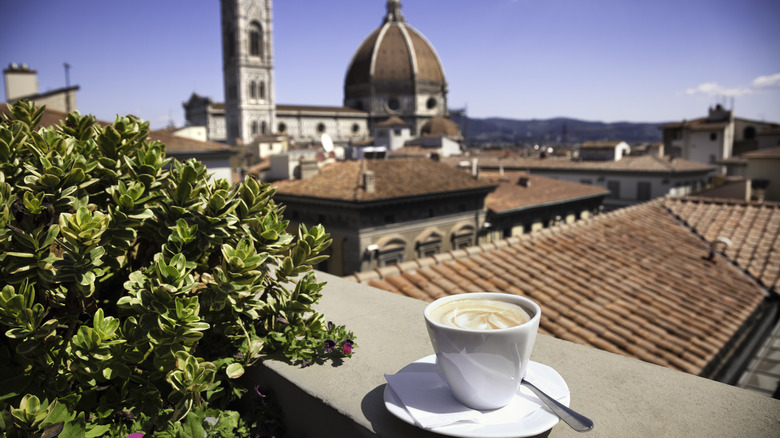
Nicolamargaret/Getty Images
Before you think this is a smack in the face to anyone who doesn’t like cappuccino, it’s not. The word “latté” literally means “milk” in Italian. So if you ask a barista for a latte, you’ll get milk or an embarrassing encounter when they ask if you mean coffee/espresso. What you actually want to ask for is a caffe latté. You can also order a latté macchiato, which is another common beverage. Between the latté macchiato and cappuccino, coffee with frothy milk drinkers will be right at home in Italia.
Cafés are everywhere in Italy. Even if you see a place that says “bar” outside, it will still serve coffee. You know that saying that you could throw a stone in any direction and you’ll hit something? That’s coffee spots in Italy. Italy invented espresso. It only makes sense that it is served practically everywhere.
Don’t accept something for free from a stranger
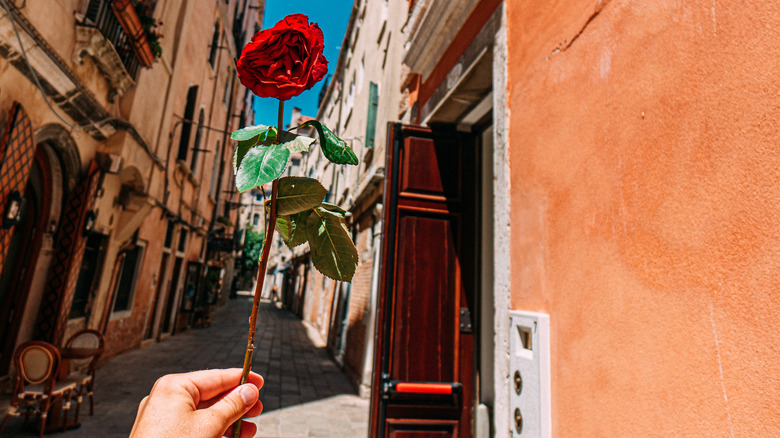
Jeremy Poland/Getty Images
Hustlers handing out “free” things to passersby is not a phenomenon original to Italy, though it is a common issue in the streets. Oftentimes, you’ll be bothered by someone trying to give you a free friendship bracelet or a flower with the expectation that you’ll tip them. Just ignore these folks or simply say “no, grazie” if you want to be polite. And absolutely do not make eye contact with or smile at the freebie givers — that’s an invitation for them to approach you.
Taking something for free doesn’t even just refer to physical objects. Hustlers will also try to coerce you into letting them take your photo for you and then demand money for their otherwise “free” service. Some may be in costume, be overly friendly, insist that their service is free, or get pesky about getting you to cooperate. Don’t be afraid to push back with a firm “no” if “no, grazie” is not a strong enough phrase.
You’re especially susceptible to these freebie hustlers if you’re in a large group, like a walking tour or a large group of travelers. Bonus points if you are all wearing matching tourist shirts. These rip-off artists will target you if you stand out like a sore thumb. A good tour guide will help you get rid of the street hustlers, but don’t assume they’ll even notice you need assistance if you’re at the back of a very large group.
Avoid pretty gelatos
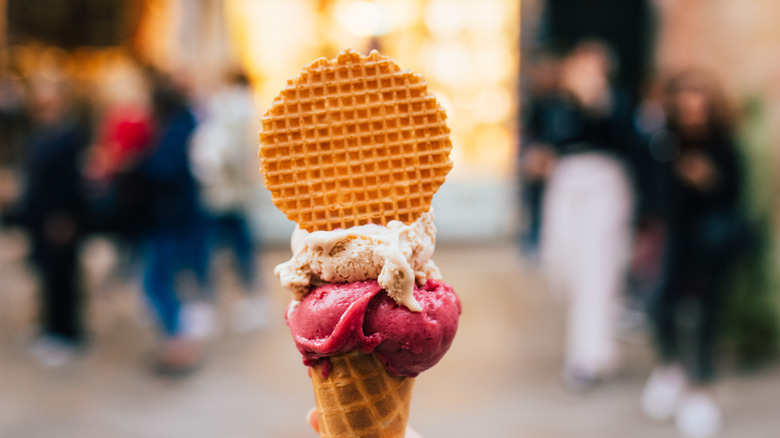
Evrim Ertik/Getty Images
People love the look of gelato in the cooler, piled high with delectable chocolates or fruits -– but these are the ones you want to avoid in Italy. When gelato is overly bright or covered in stuff, it often shows that the gelateria is not quality. The best gelato doesn’t look super beautiful, though it will taste heavenly. Overly bright gelato is riddled with artificial flavors and colors to make it look nicer, too, so it probably won’t have as rich of flavor as a more natural version.
Phrases you want to look out for when shopping around for the best gelato are homemade, made in-house, or artisanal. Often, they won’t be in English, so keep an eye out for gelato in casa, fatto in casa, or gelato artigianale, which are the respective translations. Like restaurants, watch for which gelateria is populated mainly by locals and not just tourists. Tourist-laden gelaterias are far less likely to have legit gelato.
Something else to consider is that a lot of gelaterias only take cash. So, if you want authentic gelato from a small shop, ensure you have cash with you since many of them will not take credit cards.
Don’t contest the coperto or cover charge
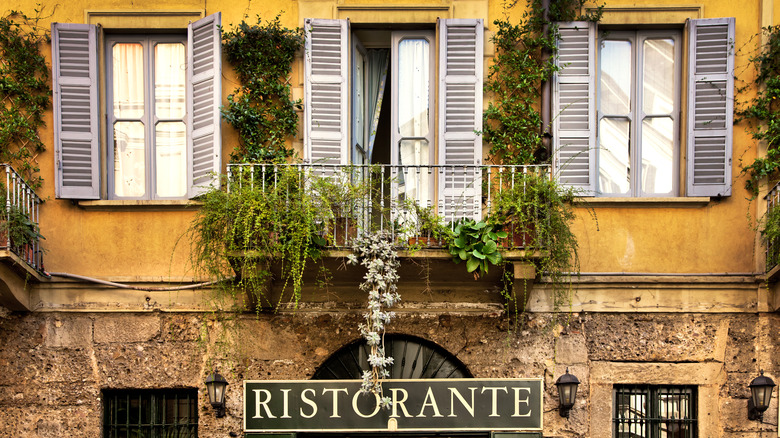
Nikada/Getty Images
Cover charges are common at restaurants around Italy. These coperto charges cover things like linens and water for the table. They are not contestable. They’re just standard practice in the country. They’re also usually just one or two euros, so it isn’t worth fighting the restaurant over. Coperto fees are legal, like sales tax, in most of Italy. The exception is the Lazio region, where Rome is located, because coperto charges were outlawed in the 1990s.
Even if the restaurant doesn’t mention using coperto charges, they may still have an additional fee like it. In Italy, restaurants don’t usually serve bread entirely for free. So you may see a small euro charge on the bill at the end for pane or pane e coperto if you are served bread with your meal. In that way, the pane fee is like a coperto charge without being called as such.
When encountering fees like this, remember that Italy’s tipping culture is much different than in the United States. It isn’t mandatory or expected. Coperto is not a tip for the staff by any means, though a few euros on top of your bill will still cost you less than if you tipped the standard U.S. 15-20%.
Don’t order a cappuccino after 11 am
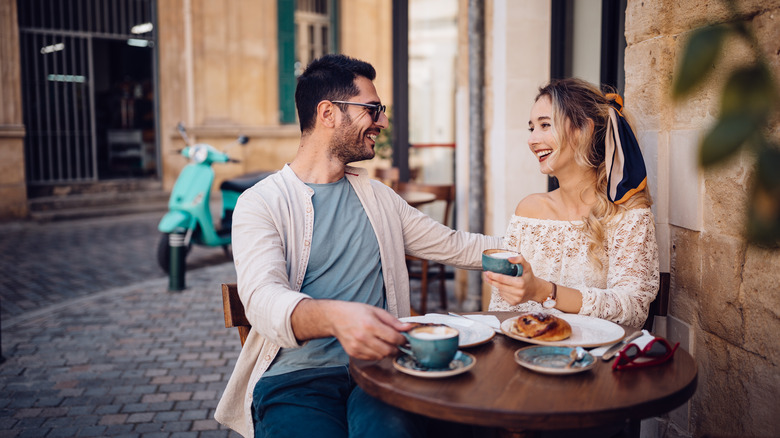
Wundervisuals/Getty Images
In Italy, a cappuccino is considered a breakfast beverage. Obviously, you can still get them in many places after 11 a.m., but folks will be judging you for it. Cappuccinos are meant to be consumed with things like pastries, not lunchtime pasta. It’s not just cappuccinos either. Any milk-based espresso is frowned upon during the afternoon because it is believed that the dairy will adversely affect your digestive system for the rest of the day.
Espresso, however, is a totally different story. Espresso can be (and is) consumed throughout the day. It is often served with a glass of water, too, to cleanse your palate before enjoying the rich flavors of Italian espresso. The barista or server will ask if you prefer liscia or frizzante/gassata water, which means still or sparkling/carbonated.
You should also know that beverage sizes aren’t really a thing in Italian cafes. If you order a cappuccino, it will be about six ounces, while a caffé latte or equivalent will be about eight ounces. American coffee sizes, or size differentiations at all, are very uncommon. It goes without saying that ordering an espresso will get you a shot of espresso. If you order an espresso, it’s okay to sip it — you absolutely do not need to shoot it like a lemon drop at a dive bar.
Don’t forget to book site tickets ahead of time
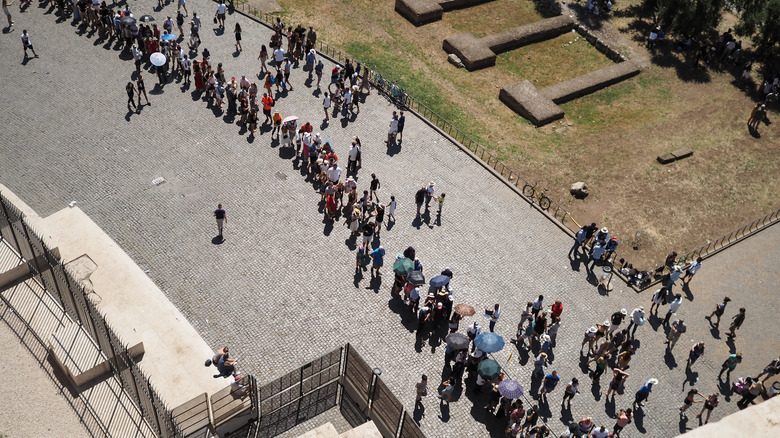
Millward Shoults/Shutterstock
When you visit Italy and want to see some of the most famous sites like the Vatican or the Coliseum, you should book tickets in advance. You don’t have to, of course, though it will save you a lot of time and aggravation. You might not get in if you don’t book ahead, especially during tourism high season. Especially if you’re visiting in the summer, not booking in advance could result in waiting in line (often in the sun) for hours.
Depending on the kind of schedule you’re adhering to, you may want to pay a little extra for skip-the-line tickets to spend less time in the queue and more time at the attraction or sightseeing. There are often other ways to acquire tickets, which could save you money. You could purchase a city pass or day tours that cover attraction tickets. Day tours frequently visit several sites, depending on where they are and how long they take, resulting in saving money and probably learning more about those places than you would going on your own.
When making your plans, list attractions from the must-sees to the could-skips. If you create an order to explore the sites, you can determine which attractions might be worth purchasing skip-the-line tickets for before heading to Italy. The splurge may be more worth it if there is a museum or location that’s highest on your list of things to see to give you more time there. Then you can save money elsewhere.
Don’t default to English all the time
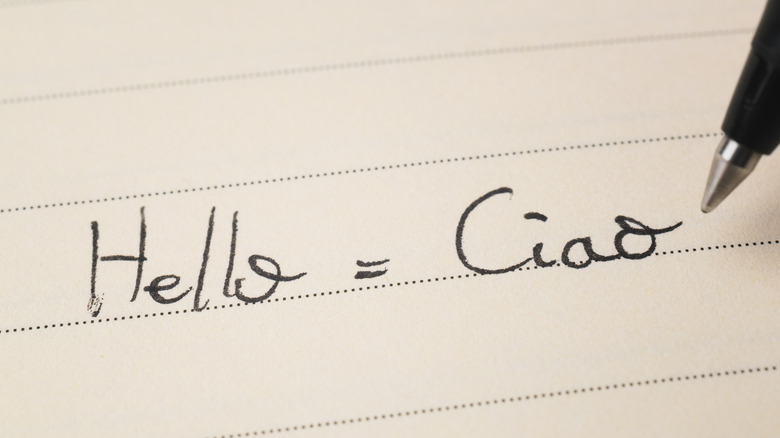
Keitma/Shutterstock
Tourist-heavy parts of Italy like Rome or Milan will have a lot of Italians, especially in hospitality roles, that speak at least some English. Even so, you should go to Italy with a few phrases memorized so that you don’t have to default to English in your daily interactions. It’ll be hugely appreciated.
Statistically, only about ⅓ of Italians speak basic English. One could assume the majority of those folks who do speak basic English live in places like Rome or Milan where a lot of English-speaking visitors go. It is even more important to be able to speak a little Italian if you are spending time outside of the country’s biggest tourism locales.
Besides the few phrases and words we’ve already shared in this piece, there are several more that you can and will use daily if you so choose. For example, Buongiorno/salve for “hello,” ciao for “goodbye,” and per favore for “please” will get you a long way socially. Everyone appreciates understanding one another’s sentiments.
Don’t expect dinner in the early evening
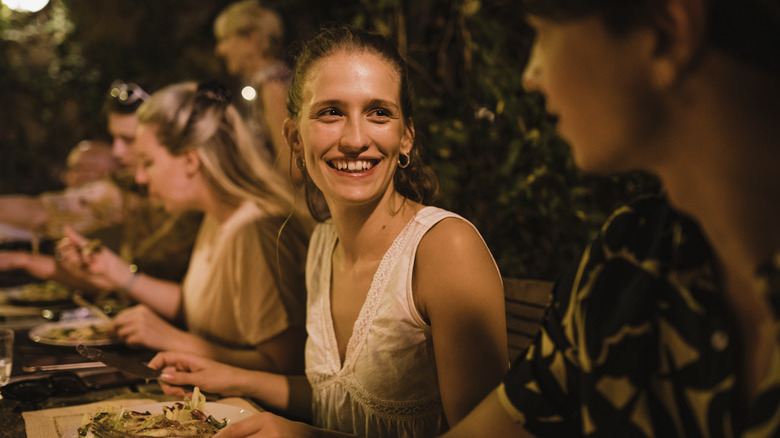
Solstock/Getty Images
Compared to the rest of the world, Americans eat dinner quite early. That can be a shock when visiting a place like Italy, where dinner isn’t really served until at least 7:30 p.m. Still, tourists are surprised when they can’t get 5 or 6 p.m. dinner reservations -– restaurants may not even be open for dining that early.
If you’re starving and it’s still too early for dinner, just look around. Some restaurants and even bars may be serving an aperitivo buffet. You can head in and order a cocktail or a drink and enjoy small bites like a curated charcuterie board. That should tide you over until the dinner services begin.
Also, some restaurants offer two dinner seating options in touristy cities. They will serve an earlier dinner for tourists or early eaters and a later dinner for locals or later eaters. It just goes to show that not all hope is lost if you need an evening meal before the rest of Italy. Still, for a fuller experience, it’s advised that you try and wait it out to fully enjoy the local culture.
Don’t order food like a tourist

Goskova Tatiana/Shutterstock
Fettuccini alfredo might be a famous dish attributed to Italy worldwide, but it isn’t really served in Italy. It is served at one particular restaurant in Rome, just not anywhere else. So you can’t just show up to a restaurant and ask for it, as it’s not on the menu. The only place with fettuccini alfredo is ll Vero Alfredo or L’Imperatore delle Fettuccine (the Emperor of Fettuccine). There, you can taste the original recipe that people worldwide fell in love with.
Putting cheese on a fish-based dish is frowned upon, like the no milk-based beverages after 11 a.m. rule. In Italy, the flavorful nature of seafood pasta is something that should be appreciated without putting cheese on it, which masks or overpowers the subtle flavors. It is also said that combining seafood with dairy is terrible for your digestive system — see a pattern? Keep that cheese far away from your Scialatielli Allo Scoglio.

